- Mar, 2024
- Mar 22, 2024
-
Hidden cameras reveal how big banks are upselling you (Marketplace) - YouTube
Some things they do are illegal, reportedly.
Bank workers get points for what they sell to customers.
‘I shouldn’t have to think more about my target than the client's wellbeing and their intersts.'
It appears the bank workers are talling customers to just pay part of their credit card interest. There's no way they can invest the rest and make 20% or something close to cover the interest.
Japan OKs stealth jet exportsーNHK WORLD-JAPAN NEWS - YouTube
Microsoft launches AI PCs - YouTube
Have a NPU chip to do AI tasks faster.
$30 per month to use Copilot already on Win11 Business.
Attempt to get more businesses to pay for Copilot on the expectation of efficiency. So far people say there are problems with it.
Besides Nvidia, no one has really made any money off AI. Could be a move to non-Nvidia companies making money off AI. The software opportunity after the hardware opportunity (everyone will have the hardware, and it'll be a question Who has the best app and stickiest services).
Microsoft, however, owns part of OpenAI.
Microsoft is a company that makes money.
Intel will provide the CPUs for these devices. - Mar, 2024
- Mar 15, 2024
-
Bitcoin. Anonymous founder. Founder disappear ed. The Satoshi coins disappeared. Lack of initial coin offering. Lack of corporate sponsor. Traded 15 months with no commercial value. The simplicity of the protocol. Outcome of the blocksize wars. All these equate to 'common property.' It's fair. A fair launch, a fair distribution.
If Saylor's company has paid $4b for their bitcoin. If he'd got it free or for 5c, would it still be considered ‘fair’? It has seasoned over time.
In 2014 the IRS designated it as property and gave it property tax treatment.
It was never able to be hacked.
It was copied, but thousands of times.
Institutionally, 2020 Microstrategy first multi-million purchase from a company. Tesla bought. Square bought.
Beware of counterfeit camcorders on eBay! - YouTube
Tape cassette walkmans are on Marketplace for $100 or $200. Discmans pretty close, too. Point and shoot cameras from the past 10 years a couple hundred dollars. - Mar, 2024
- Mar 11, 2024
-
Compact Disks make Comeback: Memory could Exceed Petabytes - YouTube
Not yet. It's from research in China. Writing on hundreds of layers on a disk. Lasers can focus and write at specific depths of the disk. Another laser will target the writes and cause them to emit light.
They didn't write about how slow writing is, nor how much energy it takes, nor where you get the laser to write like this.
#China #Technology
Story coins. jj - Mar, 2024
- Mar 05, 2024
-
Was Italy's $1 Home Scheme Worth It? | True Cost | Insider News - YouTube
Neighbors, refortifying multi-story homes, many of the young people left and leaving for the city to find work etc. $2k to $8k fees and lawyers.
They've sold almost all the houses though. Sicily towns. 10k people there but empty houses meant it could house 40k, in Sambuca. New people speak new languages etc.
Coca-Cola is adding its first permanent flavor in three years | CNN Business
'Spiced was selected because it’s “all about being on category trend and responsive to our consumer preferences,” who are craving bolder and punchier flavors, Sue Lynne Cha, Coke’s vice president of marketing for North America, told CNN.
'Coke’s research found that an “increase in consumer willingness to try a spiced beverage” and that raspberry was selected more than 5 million times on its Freestyle drink machines in 2022, which the company “often uses for inspiration” for new flavors, she said.
‘“Consumers are looking for more bold flavors and more complex flavor profiles. That’s a trend we started to see in food, but also in beverage and we though that was a unique space for us to play in,” she said, adding that there’s been of a “desire of discovery” with people wanting to try something new.’
I had this idea 2 or 3 years ago and didn't know any big bottling CEOs.
Inside The Mysterious Bitcoin City Billionaires Are Pouring Money Into | Insider News - YouTube
A city that runs like a business in (Garifuna) Roatan Island, Honduras, a place for tourists and divers, there is the town of Prospera. Special economic zone to attract foreign investment.
Can you really build a city without a government?
The Honduran committee in charge collects taxes, runs security, and approves any new laws there. Only one person is public, the others are suspected to be some American Republicans. There are no normal public services there. There is one private elementary school.
$1300 annual fee for foreigners ($260 for locals). Most are e-residents. 120 businesses have registered there. 2 weeks to get paperwork done, they say. You can pay everything, even taxes, in bitcoin.
Could become a tax haven like Caymans.
Honduras has been doing special economic zones since 2013 to attract otherwise-wary foreigners. In 2022 a new leftist leader repealed the law that allowed to creation of these zones but existing ones couldn't be shut down over night, because they're protected by international treaty for 50 years, and Propsera already sued Honduras for $11b in 2022 (ongoing).
Has its own online court to settle disputes. Are residents above the law of the land?
There is a law that says Honduras has the right to take neighboring citizens' land to expand the special economic zone. Prospera says their own laws wouldn't allow that. But maybe in 20 years, say critics. - Mar, 2024
- Mar 01, 2024
-
- Feb, 2024
- Feb 22, 2024
-
I ditched Spotify because of THIS - YouTube
This Guy is Mass Producing Factories to Build Houses | Cuby - YouTube
Each factory can produce roughly a house per day.
70% of the cost per square foot of house is the labor plus sub contractor, in the US, right now. There's not enough skilled labor. 30% is materials.
Manufacturing conveyor style. 50% the cost of standard construction. Reduce the labor force more than 10x.
'People need to buy a house as easy as to buy a car.'
With some predictable quality.
Most the production (factories) to where you want to build the houses.
He wrote a book on how to govern engineers in a business. He is a physics analyst. If he can find the physics analysis, he can predict how the system will behave itself.
They train workers before they arrive at the factory by creating a version of the factory in Unreal Engine. He plays the game version, and then when he arrives he already knows.
They have an Uber-style app for the workers. When they arrive they push a button on the app and (based on his skills) he is assigned a task. When he's finished he pushes another button.
They are preparing to use more robotics. They will give these same digital tasks (from the app) to robotics.
Use already-existing technology, so it will be familiar to any participant of the market.
#Belarus - Feb, 2024
- Feb 05, 2024
-
Man attacked for Canada Goose jacket in Columbia Heights | NBC4 Washington - YouTube
These cost like over $1000 US now, because they went viral a couple years ago. - Jan, 2024
- Jan 31, 2024
-
Heart stimulants saw biggest 2023 Japan sales rise on tourist demand
Introducing SPRING REVERBERATION 636 - YouTube
Are analog instruments gonna be mass produced again? Lots of new synth offerings and other instrument offerings as well.
Gold beans for like $60 (each bead?) You can buy one bead a day and collect them in a ‘floating bottle’ and when you have enough, you can change it to a piece of jewelry.
‘Saving consumption’. - Jan, 2024
- Jan 22, 2024
-
- Jan, 2024
- Jan 08, 2024
-
- Dec, 2023
- Dec 29, 2023
-
- Dec, 2023
- Dec 19, 2023
-
These Bricks Can Absorb Traffic Noise - Thesis Presentation on Helmholtz Resonators - YouTube
20-300hz, because they're looking at low pitch from traffic. - Nov, 2023
- Nov 30, 2023
-
https://www.youtube.com/watch?v=aqBWhQ09qNM
Hostile architecture
https://www.youtube.com/watch?v=u_OtUBnxjc8
But it's ‘for a retro look'?
- Nov, 2023
- Nov 04, 2023
-
“Smart” = unfixable
- Oct, 2023
- Oct 17, 2023
-
- Sep, 2023
- Sep 25, 2023
-
Newspapers in Japan now have seeds in them.
- Sep, 2023
- Sep 04, 2023
-
HP sued over scanner that requires ink; their defense is RIDICULOUS! - YouTube
The CEO of HP would be an interesting interview. A person who makes these kinds of decisions.
-
A meetup on SM.
Return of folk music?
This song shot to popularity so fast.
It's be exhilarating to watch when it comes. Or to be a part of?
Also, community.
First time in years I think I've heard a song about SOMETHING. It's not deep, but at least it's about something at all.
Culture battle? (against government? For control of government?)
Her fans don't listen. They just watch her.
- Aug, 2023
- Aug 21, 2023
-
Dakou - Scapped tapes and CDs sold to China as reusable plastic (80s?)
- May, 2023
- May 15, 2023
-
- Apr, 2023
- Apr 25, 2023
-
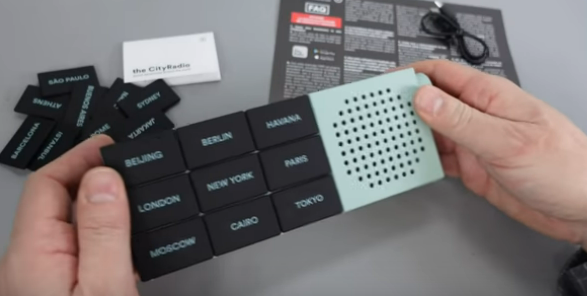 City Radio, from Italy. (But without being actively connected to phone it doesn't work, so it's actually just a speaker with hotkeys).Internet radio. Bluetooth. Push buttons for their city's radio station. Four buttons on top (power, memory, left, right), plus a knob on the side for volume (no tuning?). Bluetooth(insecure). Non-replaceable (for people without a screwdriver) battery, charged with USB.
City Radio, from Italy. (But without being actively connected to phone it doesn't work, so it's actually just a speaker with hotkeys).Internet radio. Bluetooth. Push buttons for their city's radio station. Four buttons on top (power, memory, left, right), plus a knob on the side for volume (no tuning?). Bluetooth(insecure). Non-replaceable (for people without a screwdriver) battery, charged with USB.
Download an app(secure?) on phone. Connect phone via bluetooth(insecure). You program on your phone which buttons on the radio tune to what stations.the CityRadio - Hear the world - YouTube - Nov, 2022
- Nov 15, 2022
-
 EVs are not reliable currently, due to them being a new manufacture.
EVs are not reliable currently, due to them being a new manufacture. - Jun, 2022
- Jun 10, 2022
-
LVMH owns the most high fashion brandsIt revenues $55b per year. Karans, the second biggest, makes a quarter of that. But Kering's strategy is to own top tier brands. Gucci is the 'most popular' among genZ and TikTok. YSL and Balenciaga are also SM favorites.
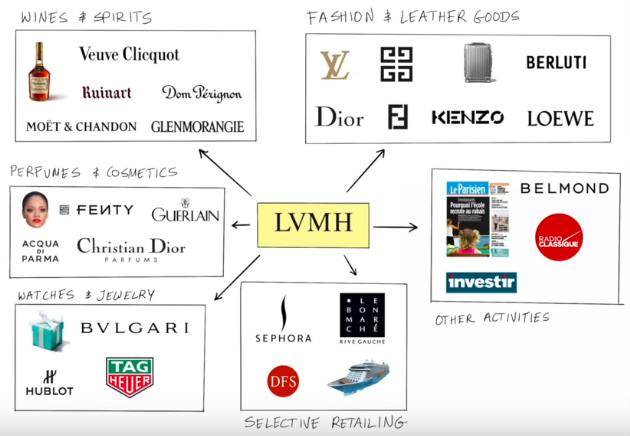 Karen's:
Karen's: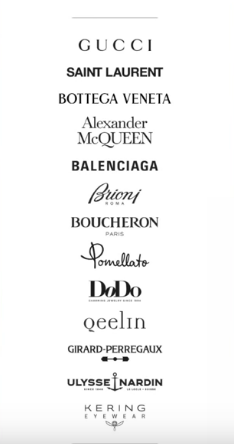 Gucci's 'blitzkreig strategy of putting their brand on things and charging thousands for everyday items of a large variety of sorts, including baby clothes and skateboards. They sell to cheaper wholesalers department stores and and outlets where people can buy their products for less (they cross out the $1599 and put $800), in addition to their almost 500 shops where the staff sometimes wear white gloves. They sell the items that haven't changed for decades to some customers and other products to people who want the brand but also want something trendy they can wear. They capitalize on trends. New products account for 30% of their business. They do lots of licensing.55% of their customers are 35 or younger. Gucci invests like 12% of it's budget or something in advertising.
Gucci's 'blitzkreig strategy of putting their brand on things and charging thousands for everyday items of a large variety of sorts, including baby clothes and skateboards. They sell to cheaper wholesalers department stores and and outlets where people can buy their products for less (they cross out the $1599 and put $800), in addition to their almost 500 shops where the staff sometimes wear white gloves. They sell the items that haven't changed for decades to some customers and other products to people who want the brand but also want something trendy they can wear. They capitalize on trends. New products account for 30% of their business. They do lots of licensing.55% of their customers are 35 or younger. Gucci invests like 12% of it's budget or something in advertising.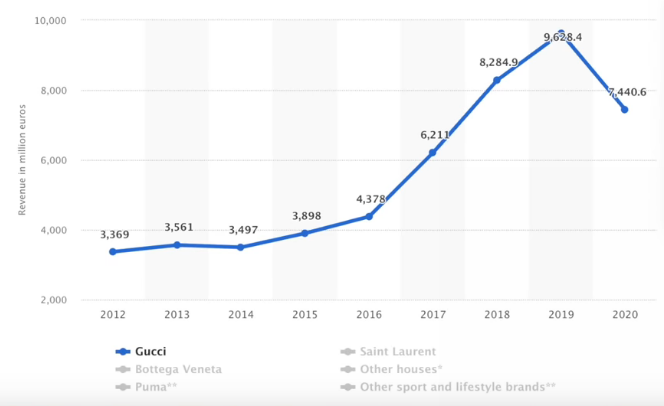 YSL is a mid-price range, conservative company that sells their black bags with big YSL logos and other products, and doesn't change their products much.Another brand is Hermes, who never advertises, never sold online, or even displayed publicly, and and they're 'more lucrative and successful' than Gucci. They sell to their list of the highest spending customers. It takes no pre-orders or waiting lists, and doesn't expand inventory or scale production. Not everyone can buy their products. Their products appreciate value. They have no returns. They manufacture products by hand in France, where they have 45 factories (85% of products). Each bag is made by a single craftsman (after extensive training) in France. A craftsman makes 2-4 bags per week. They're independent. They gross close to what Gucci does. They have 306 stores. 75 in Europe (13 in France), 45 in the Americas (29 in the US), 95 in Asia (29 in Japan), and 6 in Oceania. Their star product is their handbags, which sell for $10,000s to $100,000s. You get to buy their bags by being a regular in their stores and buying their shoes and other products, and after they spend a lot they're offered a chance to buy a bag. The customer is one day notified and taken to a room in the back. Some people buy the 1-3 bags they're shown even if they don't really want them to demonstrate loyalty and stay on the list. Their bags are constantly resold and appreciate 15% per year.
YSL is a mid-price range, conservative company that sells their black bags with big YSL logos and other products, and doesn't change their products much.Another brand is Hermes, who never advertises, never sold online, or even displayed publicly, and and they're 'more lucrative and successful' than Gucci. They sell to their list of the highest spending customers. It takes no pre-orders or waiting lists, and doesn't expand inventory or scale production. Not everyone can buy their products. Their products appreciate value. They have no returns. They manufacture products by hand in France, where they have 45 factories (85% of products). Each bag is made by a single craftsman (after extensive training) in France. A craftsman makes 2-4 bags per week. They're independent. They gross close to what Gucci does. They have 306 stores. 75 in Europe (13 in France), 45 in the Americas (29 in the US), 95 in Asia (29 in Japan), and 6 in Oceania. Their star product is their handbags, which sell for $10,000s to $100,000s. You get to buy their bags by being a regular in their stores and buying their shoes and other products, and after they spend a lot they're offered a chance to buy a bag. The customer is one day notified and taken to a room in the back. Some people buy the 1-3 bags they're shown even if they don't really want them to demonstrate loyalty and stay on the list. Their bags are constantly resold and appreciate 15% per year. -
Some fashion fans say high fashion brands are collabing with much cheaper brands... and they don't know why.Balenciaga, Gucci, Prada have all collabed with Adidas. Miu Miu with New Balance. Givenchy with Disney. GAP with Jeezy and Balenziaga.Jersey $1750 (Adidas/Gucci) (Actually the figure is for pounds but I don't have that key)Shorts $1250Bag $3100Sneakers $650Gucci shorts are $600. Half.
-
2 months into the Swatch/Omega MoonSwatchHuge lineups outside shops. Limit of purchase to 2, then to just 1.The watch costs $300.The product launch has been compared with an Apple product release.Was it all just due to herd mentality? Was it because they could finally afford an Omega? Was it their first Omega? Did it happen through word of mouth or social media advertising or for resale on the grey market? There are thousands listed on eBay now for $350 to $1000. One was sold for $8000, it seems. Swatch only sells their watches at select stores, it's doesn't seem to want to sell online.Omega fans, some asked to have their names taken off list after this collab. It's not really exclusive now.Omega is owned by Swatch, and some have said Omega had to comply although they weren't for it. Does the move do justice to the Omega brand? Omega is known for quality movements, and the new watch is a return to quartz. It's plastic (bioceramic), not metal. It's been said to have a cheap, light feel. The dye runs, reportedly.People are wearing it as a fun, affordable accessory. It's high fashion. It's trendy. They're exclusive again because their production is limited and prices are bidded up.There's no knowing where the future of a launch like this goes. The thing can easily be replicated.

-
Shein, growing fashion brandShein launches 3,000 to 4,000 new (fast fashion) female apparel products every day, reportedly. $2 to $30 per item.Their product line is updated much faster than any other fashion brand (Zara, ASOS, H&M).Shien is valued at $100b, more than H&M and Zara combined. However, H&M did $24b and Zara $19b last year, and Shein did $10.They're private and don't give interviews. The CEO has only been seen a couple times.They say they were founded in 2012, but others say in 2008 with Dianwei (knock offs and stuff, reportedly). So they developed along with mass adoption of smart phones (helps with product discovery). Also collected user info, algos, and the continuing development of Chinese manufacturing and distribution, as well as China-friendly global community.Shein within China doesn't have the advantage it has over other world brands in the global market, because China is a more saturated market. It can't compete for speed and price like it does against the US.Shein also made timely payments to suppliers (a rarity in China, reportedly) made it able to get smaller production orders. Small order, quick response. 100 to 500 items as the first batch (3 to 5 days), versus Zara's 100k items. No middle man or import tariffs because they're shipped straight from China to customers (not to retail chains).Shein pays quite a bit for marketing. It pays influencers and celebs. They do a thing called a 'haul,' in which a tik-toker or instagramer buys/receives a big box, like $500 or $2000 worth, and they try it all on and stuff. This goes viral and creates its own marketing campaign. It's an algo that works through influencers and young women.Shein was the #1 downloaded shopping app in 2021.Shein's growth has recently slowed with the China city lockdowns.Several independent fashion designers have gone on social media alleging Shein has knocked off their design to the tee. Exactly the same, and they sell the things for way less. Doc Marten's and Levi Strauss have sued them. I think to do this you have to be registered in China.Shein contracts a lot of work to small factories and there are workers who are not in the social welfare system there, whatever the relevance of that is. This is the key to cheap, fast products like this. It's simply finding ways to pay workers less than other places.An issue lots of people talk about with these fast fashion mass sales brands is waste. 100m tonnes of clothing are dumped in landfills every year now. These products are made to be used once or several times, and they are not good for a second-hand market (for example, a lot of first world used clothing is sent to Africa, and it still is, but they say the fast fashion stuff is not useable, it's basically garbage shipped to them).Producing textiles is energy intensive, and is often done where there are less regulations which consider the environment. It's been interesting as an example of how the young generation, which has been perceived as more environmentally conscious and critical of past generations waste, doesn't really care because they seem to prefer the less expensive product regardless, because it's what they can more easily afford.
- May, 2022
- May 16, 2022
-
- Oct, 2021
- Oct 13, 2021
-
3d printed gun inventor dies of heart attack at age 28, days after his house was raided by policeHe invented and publicized a totally 3d printed gun (unlike previous/other ones that required purchase of a bolt or magazine to be bought the old fashioned way). Every part of it except the barrel, which could be made at home as well. His gun was called FGC-9 ('fuck gun control 9mm').He was raided after financial companies reported his unusual purchased to law enforcement, reportedly.Many raised questions about his death, having occurred so soon after a raid by a force related to those who probably investigated and confirmed the normalness of his death (they reported he had a heart defect), combined with his age.However, 1 in 5 heart attacks are now for people under age 40. That means 0.3% of people between 20 and 40 have heart attacks. However, the average age for a first heart attack is 65 for men and 72 for women.Note, though, that having a heart attack is not the same as dying from a heart attack, I don't think, anyway. I didn't see stats for dying of heart attack under age 30.Quotes said by the guy, JStark, on YouTube: "There are certain circumstances in our life that are unfortunate, and which make living kind of painful, and sometimes I do not have anything to look forward to. But with me, I have nothing to lose. And to accept the risk to be able to die at any time basically. Live free or die. These are not empty words. ... We do not want harm for anyone. We want everyone to live peacefully amongst each other. And we want people to have the freedom of speech and the right to bear arms. If that's too politically extreme for you, fuck yourself."
- Jun, 2021
- Jun 27, 2021
-
New Suzuki Jimny sells out in seconds... in Mexico. Suzuki doesn't make cars to sell in the US.
It's also selling out in Europe and anywhere it's available.It's a very small, low-powered, very uncushy (over bumps) jeep-like SUV that's the 'new thing.' It costs $20k. It has nothing extra, but does have many of the things you want in a vehicle (AC, cruise control, charge port in rear interior for a tire pump). A comparable vehicle is the Jeep Wrangler which costs just under $30k.They made 1000 to see if people wanted them in Mexico, and they sold out in under a minute online. They offered another 1000 and same thing.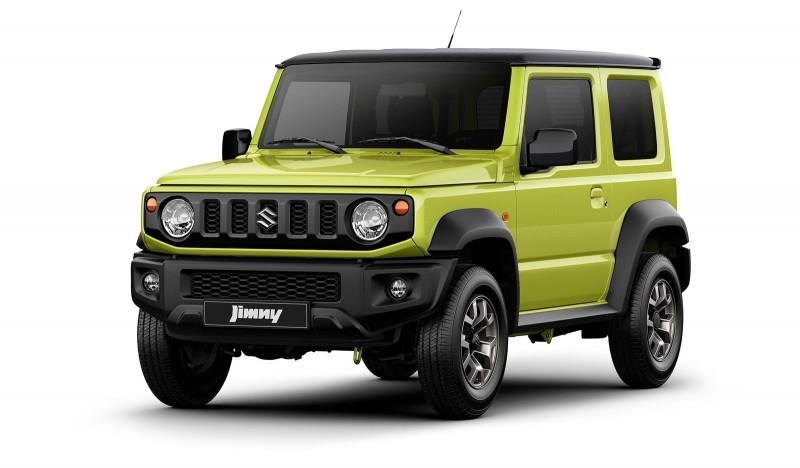
Show More
Show Less